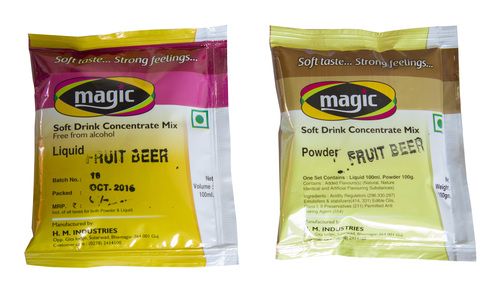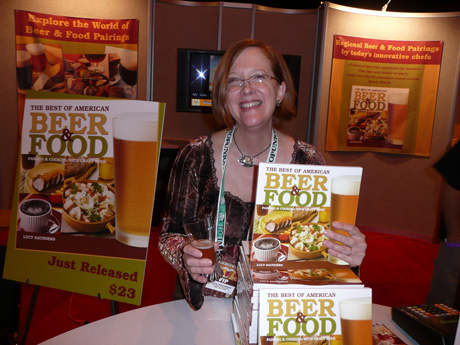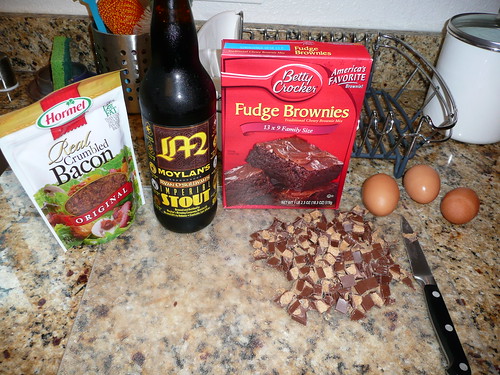
Today in 1986, US Patent 4590085 A was issued, an invention of Daniel R. Sidoti, John H. Dokos, Edward Katz, and Charles M. Moscowitz, assigned to Anheuser-Busch Incorporated, for their “Flavor Enhancement And Potentiation With Beer Concentrate.” Here’s the Abstract:
A new method for intensifying the inherent flavors of foods and for imparting other desirable organoleptic properties is disclosed. The method consists of adding to foodstuffs a flavor enhancing amount of a heat denatured concentrate of beer. There is also provided a process for producing the above described concentrate.

While the abstract doesn’t tell us too much, the background from the application is very interesting, as it talks quite a bit about beer in cooking, which appears to be the primary goal of the patent’s use, although the patent has lapsed, so I don’t know if it was ever used in a commercial product. I know there have been, and even currently are, powdered beer products on the market, this one seems aimed at adding beer flavoring to cooking, rather than being able to make instant beer by adding water.
BACKGROUND OF THE INVENTION
Foodstuffs of all varieties whether precooked, served hot or cold, or whether prepared without cooking have flavors, aroma, and other organoleptic properties that influence the sensory perceptions of human taste. The manufacturers of such foods as sauces, spreads, dips, soups, dressings, stuffings, garnishes, meats, fish, vegetables, salads, breads, etc. whether dry, frozen, refrigerated or canned, desire to produce products organoleptic properties closely profiling the natural flavors, aromas and textures that appeal broadly to the sensory perceptions of the consuming public. A food whose natural flavors are unduly masked may be too bland, or if overly modified with added flavor components, it may be perceived as too spicy. The availability of spices, condiments, etc., permits the individual consumer to adjust the flavor of food purchased from the shelf to suit his or her particular taste preference.
Nevertheless, food manufactures because of the nature of precooking processes, the addition of preservatives, the packaging and keeping techniques of retorting, pasturization, etc. will often times find that the desired natural flavor of the foodstuff has been suppressed below the threshold taste perceptions of the average consumer. Accordingly, techniques for addressing this deficiency have become customary to the industry.
One such technique involves the use of chemical compounds which intensify the flavors inherently present in food without adding any flavor from the chemical itself. These compounds are known as Flavor Enhancers and include, for example, linalool, 2-nonenal which is used to enhance the flavor of coffee, and certain sulfur containing amino acids which are used to enhance meaty flavors. Other chemicals serve as flavor enhancers through reacting with endogenous flavor components of food itself to synergistically promote the combined flavor effect of those components.
Another technique which is commercially employed to address the problem of suppressed natural flavors is that of using chemical compounds which when added to foods in very low concentrations to catalytically create desirable organoleptic properties of the foodstuff otherwise undetectable. These compounds are known as Flavor Potentiators, and like Flavor Enhancers, their taste is not itself detectable to the sensory perceptions of the ordinary consuming public.
There are drawbacks, however, to the previously known Flavor Enhancers and Potentiators. One foremost disadvantage is that these compounds are selective in their functional contribution to flavor development. The same compound which enhances coffee flavor may have a deleterious effect, if any effect at all, on, for example, cheese flavor. Accordingly, some food products such as soups, dressings and some pastries which have a combined variety of natural flavors are extremely difficult to potentiate or enhance from previously known chemicals.
Another serious drawback to previous flavor enhancement and potentiation techniques is that they require the addition of chemical compounds which have no nutritional value themselves nor are they derived from natural food or beverage constituents.
It has now been found and this finding forms the basis of this invention, that Flavor Enhancement and/or Potentiation can be achieved by the addition of denatured beer concentrate to foodstuffs of all types and varieties, whether cooked or prepared fresh, without the need to employ non-nutritional, chemical compounds.
It should be appreciated that cooking with beer is not new. The book Cooking With Beer by Carole Fahy, first published in 1972 by Elm Tree Books, indicates that the brewing of beer is known to have been practiced in Mesopotamia and Egypt at least 5,000 years ago. The Egyptians passed on their knowledge of brewing to the Greeks who in turn handed it down to the Romans who refined the Anglo-Saxon form which was already in place at the time of the Roman conquest. English ale became the basis for many religious and social festivals and is said to have accompanied bread as the sole breakfast menu of Queen Elizabeth I.
Ales and beers are all manufactured beginning with mashing barley malt and possibly grain adjuncts such as barley, corn and rice. This is filtered, brought to boil, pitched with hops and result in a wort which consists of water, dextrine and fermentable sugars. The wort is then fermented with yeast.
English ales have been traditionally distinguished from American brews or lagers primarily on the basis of the type of yeast employed to ferment fermentable sugars of the precursor wort into alcohol. Secondarily, there is a distinction between the ratio of malt and grain adjuncts in the mash in that ales customarily have far less, if any, grain adjuncts. Also there are distinctions in the level of hop addition. These factors contribute significantly to the variations in taste of American brews or lagers and ales.
Beers have gained some limited acceptance in cooking as a consequence of their richness, delightful taste, their ability to improve the texture and lightness of cakes, pies and batters; their tenderizing effect on tough meats; their contribution to preserving foods; their ability to make breads rise; their adding piquancy to dull vegetables and attractively glazing roasted meats and a few other culinary virtues. However, each of these benefits is owed to the full compliment of the beer flavor and texture attributes present naturally and, in the case of assisting cakes to rise, its fermentable state with its residual yeast in active form and its carbonation being readily apparent.
It has been determined however, that the use of beer in cooking does have its limitations. For example, if you are making a soup which requires dried vegetables according to Carole Fahy in Cooking With Beer, you must make certain that you soak them thoroughly, overnight, before use because the hard pellets will otherwise sink to the bottom of a rich vegetable beer soup apparently due to slow diffusion of beer molecules through the surface membrane and interior of the dried vegetables. Additionally, when sieving foods as for example, soups, the richer the beer is, the more difficult to push entirely through the strainer without losing some of the desired flavor. Still further, it is found necessary to cook foods longer with beer to fully develop the flavor. Finally, and perhaps most importantly, cooking with beer imparts of a clear beer flavor to the foodstuffs tending to mask the inherent natural flavors of the other foodstuffs. Accordingly, beers, although employed previously in cooking, have not been used nor thought to have any Flavor Enhancing or Potentiation functionality. Likewise, previous beer extracts or concentrates have had no utility in flavor enhancement but rather have been prepared in undenatured form in order to be reconstituted into either alcoholic or nonalcoholic beverages.
British Patent No. 2127 describes the prepration of a nonalcoholic beer extract or concentrate. Although the concentration can be effected in any efficient vacuum evaporation apparatus, the first end to be attained is the separation of the alcohol produced by fermentation at as low a temperature as possible. After separation, as disclosed in this patent, the temperature may be raised, but the subsequent evaporation must be carefully conducted otherwise aromatic compounds present may be expelled or destroyed and the color of the product materially increased. The product is said to be pleasant to the taste and to possess all the nutritive and feeding properties of original beer before removal of the alcohol and subsequent concentration. The product is employed as an ale concentrate designed to be reconstituted into a non-alcohlic beverage by the addition of water.
British Patent No. 1,228,917 discloses a dry extract of a fermented beverage. However, it is compounded with dry yeast in live active form, together with dry fermentable carbohydrates or dry unfermented wort containing fermentable carbohydrates in order to permit fermentation when diluted. The boiling evaporation utilized to produce the extract is under a vacuum high enough to take place at the predetermined low temperature of 100° F. The original fermented beverages and their respective solids or residues and the yeast are protected during evaporation by the low temperatures. The evaporation at yeast-preserving temperatures with minimum of exposure to the heat also preserves the solubility of the enzymes of yeast and, therefore, the yeast remains in active condition so it will act vigorously when the extract is diluted with water for the preparation of a beverage.
In British Patent No. 1,290,192, a beer extract is produced from evaporating a partly fermented beverage at temperatures below 80° F. or any other suitably low temperature that will preserve the constituents of the reduced wort in a soluble state. The extract contains fermentable substances with the same characteristics of the beverage from which the extract was made. It possesses the characteristic flavor and taste of the original beverage that can be produced and imparted by yeast fermentation and is naturally alcoholic; and when suitable diluted with water, provides a beverage having the flavor and taste of the original beverage. The yeast, however, is used in large quantity for example, twice as much in respect to the amount of fermentable carbohydrates as is usually employed to pitch ordinary fermented beverages.
SUMMARY OF THE INVENTION
It is an object of the present invention to provide a new and useful technique for flavor enhancement and potentiation intensifying the inherent natural flavors of food and creating desirable organoleptic properties to a broad range of foodstuffs with a derivative of a nutritious foodstuff natural concentrate despite having substantially denatured the components of flavor and color, consistency, solubility and fermentability from the concentrate.
It is a further object of this invention to provide a new and useful concentrate of beer and its method of manufacture.
These objects and others are fulfilled by heat treating a fermented malt beverage or beer at sufficiently high temperatures to substantially denature the product and adding it at very low levels to foodstuffs. The denatured beer concentrate is added in amounts below which the concentrate is detectable in taste or mouth feel, but sufficient to achieve flavor enhancement and potentiation.













